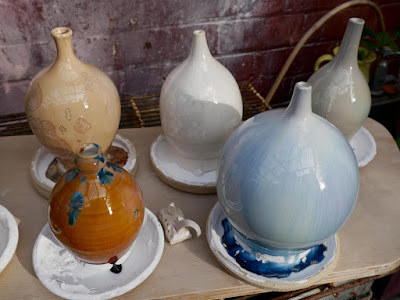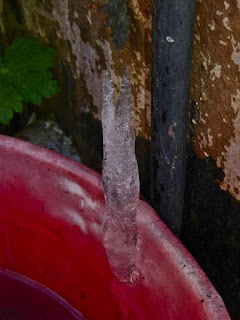Another Crystalline Glaze test firing.... and a glimmer of success at last!
If you have been following this blog lately you will know that I had two crystalline glaze firings in March, both of them were blighted with really bad problems with blistering of the glaze, crystals failing to grow, and the glazes appearing like they had been fired too high. The results were puzzling and something I had rarely encountered before. What was interesting was that only the vases that I fired were affected, but any test piece I fired came out well with few faults. I learnt a lot from each bad firing, and having examined the evidence, began to suspect that the liner glaze I used inside the vases was at least in part to blame for the trouble. None of the good test pieces had a liner glaze, only the vases with the glaze faults had it.
I made more pots to test my idea about the liner glaze. Most of the new pots had narrow openings and did not require a glaze inside them, so that enabled me to try the crystalline glazes without the troublesome liner on full sized objects rather than the smaller testers I had used before. Testing on larger objects also would help determine if glaze thickness was part of the problem as I do apply glazes thicker when working on a larger scale.
I also included a vase in this firing that had the liner glaze, but had three stoneware glazes on the outside that I regularly use, so that I could see if the liner glaze adversely affected them.
I tested three different crystalline bases, two used Frit 4110 which is a high sodium frit that is often used for crystalline glazes, and the other glaze used potash feldspar rather than frit.
I fired a total of 7 pots in a manually operated 3.5 cubic foot kiln that I often use for crystalline glaze firings. This was fired to cone 9 with tip lightly touching and took about 8 and a half hours to reach peak temperature, half hour cooling to about 1075 C and a further 4 and a quarter hours holding that temperature to ... hopefully.... grow the crystals.
Due to having rather a restless night I foolishly started the firing at 2.45am, and finished it at 4pm. This was rather a marathon, but felt more productive than tossing and turning in bed and starring at the ceiling!
I was able to unpack the kiln the following day.
My first glance in the kiln showed very few crystals, which was a little disappointing, but it was really great to see that all glazes appeared to be free of the horrible disfiguring blisters that had ruined the work from the previous two firings.
I found that things were better than I thought when I unpacked the work.
The stoneware glazed pot that had the troublesome liner was completely alright and looked rather nice with the three glazes overlapping each other. One of the glazes was more colourful than I remembered it, and they all had benefited from the 4 hour soak at 1075 C as the tiny crystals that were a normal part of the glazes had improved and made more of a stone-like surface that was smooth and pleasant to the touch.
The best crystals occurred where I added one percent red iron oxide and three percent manganese dioxide to one of the 4110 Frit glaze bases.
The same glaze base with three percent manganese dioxide and no iron oxide produced smaller crystals and a slightly darker overall colour.
The charming dark blue "flowers" on the shiny toffee coloured pot are from nickel oxide. These were pleasing to see, but there should have been more of them and the glaze looked somewhat over fired.
This white pot with lines of feathery blue is the same frit based glaze that successfully grew crystals when manganese and iron were added to it. Usually this base glaze reliably produces white crystals on a white background with no trace of blue. In addition to the 25 percent zinc oxide that the glaze contains it also has about 5.5 percent of titanium dioxide, and those are normally more than enough to make nice crystals.
This used the same base, but with one percent iron oxide added to it. The strange blue discolouring is still present and this makes the warm off-white iron colour a bit odd looking, but the glaze has managed to produce a few small crystals.
In the centre of the back row is a white pot that is a lovely pure white that has no blue through it. This was the only crystalline glaze in the firing that did not use a frit, the glaze being built around potash feldspar. It is a little hard to see the crystals, and they only really appear as a group on one side, almost as if they are emerging from mist.
The fact that this glaze is pure white without any blue tells me that the odd blue colour that occurs in the frit based glaze may be caused by the frit. I do remember that, about the time I bought my bag of frit, another local potter had a bad firing when her usually copper green glazes turned much bluer and were more fluxed than she had experienced before.... she also used frit 4110 and complained that it had changed.
I wonder if the blue is a boron blue? The glazes are very low in alumina and the frit contains some calcium which is an ideal scenario for developing boron blues, the blue colour I understand to be caused by the formation of tiny calcium-borate crystals.
My wife also had an interesting idea that the nickel in the glaze of one of the nearby pots may have fumed and discoloured the glaze? I certainly have had this happen with chromium oxide fuming and discolouring a crystalline glazed pot in the past and so I am very open to entertaining possibility of nickel doing this as well. I can test that one in the next firing by keeping it nickel free.
What I have confirmed from this test is that the blistering in the previous two firings was caused by the liner glaze.
If a crystalline glaze is too thin then the slight roughness of the clay body of the pot is enough to stimulate an over supply of crystals as they tend to locate around something that irritates them, because of this crystalline glazes are usually applied much thicker than regular glazes, but I may have taken this too far as some irritation from the clay body can be a good thing!
Another thing that affects how many, if any, crystals make a start on a pot is the peak temperature that the glaze is fired to. If the peak is too high then few if any crystals may form, and if the peak is too low.... far too many crystals may cover the pot. The scarcity of crystals tells me that I may need to reduce the peak temperature.
So.... next firing will be cone 8 instead of cone 9. No nickel in the kiln and a thinner glaze application. I will also test alternative liner glazes.
It is good to have enjoyed a glimmer of success at last!











Comments
Still, a little progress is better than none.
Always plagued with blisters on the pots, every single time. Going to give it a go without the crystalline liner
glaze and with a stoneware glaze as a liner to see what happens. Our crystal growth is great, but always blisters.
Thank you so much.
Thanks again for your insight.
Peter and Gill
I am delighted to hear from you. I always write in hope that the ups and downs I have with glazes might possibly be of help to someone else... as well as it being a useful reference for me to look back on sometimes when I am feeling rather absent minded and can't remember what I did last time!
I do commiserate with you regarding the blisters, it is a very disheartening thing to deal with and can be very difficult to isolate the cause. It would be a very good thing if you could try a test with no liner at all, and then some with a selection of stoneware liners and see what happens. I will be trying tests with probably three different liner glazes next time I fire crystalline, and see which ones work.
My first crystalline glazed pots (back in 2010) were usually with a dolomite matte type liner glaze, and those worked well, but I didn't always enjoy the white interiors and later changed to temmoko style liners, which until recently seemed to work well! Sometimes I used crystalline inside and out (which you may be doing???), but I occasionally had blistering around the pot near the rim, especially if the pot was thin, and I often found it hard to control the pooling of the glaze in the bottom of the pot, which could run too thick if I wasn't careful enough.
Anyway, the very best of luck, and it would be lovely to hear back from you as to how your next crystalline firing goes.